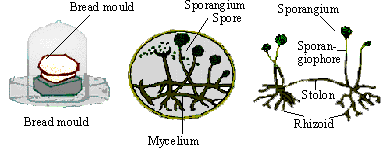|
PinkMonkey Online Study Guide-Biology
14.4 Kingdom : Fungi
The fungi are non-green plant-like organisms which are
universal in their distribution. They grow in dark and moist habitat and
the substratum containing dead organic matter. Mushrooms, molds and yeast
are common examples of fungi.
Fungi are distinguished by the following characters:
(1) They have a definite cell wall made up of fungal
cellulose.
(2) They are without chlorophyll, hence they are heterotrophic.
(3) They are usually non-motile.
(4) They reproduce mostly by spore formation. However,
sexual reproduction may also take place.
Structure: The plant body is unicellular or multicellular.
When multicellular, it is composed of profusely branched, interwoven,
delicate, thread-like structures called hyphae, collectively called
mycelium. Hyphae may be aseptate or septate. When aseptate they
are coenocytic, containing many nuclei.
Fungi are heterotrophic in nutrition i.e., they may be
saprophytic, (living on dead organic matter) or parasitic (subsisting
on other living organisms). The parasitic forms may be ectoparasite, living
on the body of the host, or endoprasitic, living inside the body of the
host. Some forms are symbiotic.
The fungi are classified as follows:

1. Class : Zygomycetes (lower fungi)
These are filamentous fungi which are terrestrial growing
on moist, dead organic matter. They are mainly distinguished by the following
characteristics :

Figure 14.37 Mucor Figure 14.38 Rhizopus
(i) The plant body is called a mycelium; it is made up
of interwoven, thread-like structures called hyphae.
(ii) The hyphae are aseptate and coenocytic.
(iii) The sporangia are formed at the apex of aerial hyphae called sporangiophores.
(iv) The spores are numerous and are formed endogenously
(i.e. produced within the sporangium).
(v) Sexual reproduction is isogamous (i.e. the pairing
gametes are alike).
(vi) The zygote is unicellular and simple.
(vii) Motile zoospores are produced in some.
|
Heterothallism
In some fungi there is no morphological sex differentiation, but they show physiological sex differences and said to be having +ve and -ve strains. Such fungi are called heterothallic. (heteros= dissimilar). In these fungi sexual reproduction can occur only between thalli having +ve and -ve strains.
|
Reproduction : Mucor reproduces asexually as well as sexually. Asexual reproduction takes place by formation of non-motile spores and sexual reproduction takes place by conjugation of similar gametes (isogametes).
During asexual reproduction, mycelium gives out upright
vertical hyphae called sporangiophores. As the growth proceeds, the tip
develops a globular structure called sporangium. At maturity the
sporangium breaks open and liberates the spores. On germination, each
spore develops into a new mycelium.
Sexual reproduction is isogamousas: it involves
the conjugation of two similar gametes. During conjugation the two hyphae
regarded as having positive and negative strains come closer (heterothallism).
The conjugating hyphae give out club-shaped progametangia which release
the terminal part (called gametangia). The gametangia fuse, the middle
wall is dissolved and the nuclei fuse in pairs, thus forming a zygote.
The latter develops a thick resisting wall to form a zygospore.
Each zygospore, on germination, gives out promyucelium which develops
sporangium at its tip. When the sporangium ruptures, the spores are liberated
and germinate to produce new mycelia.
|